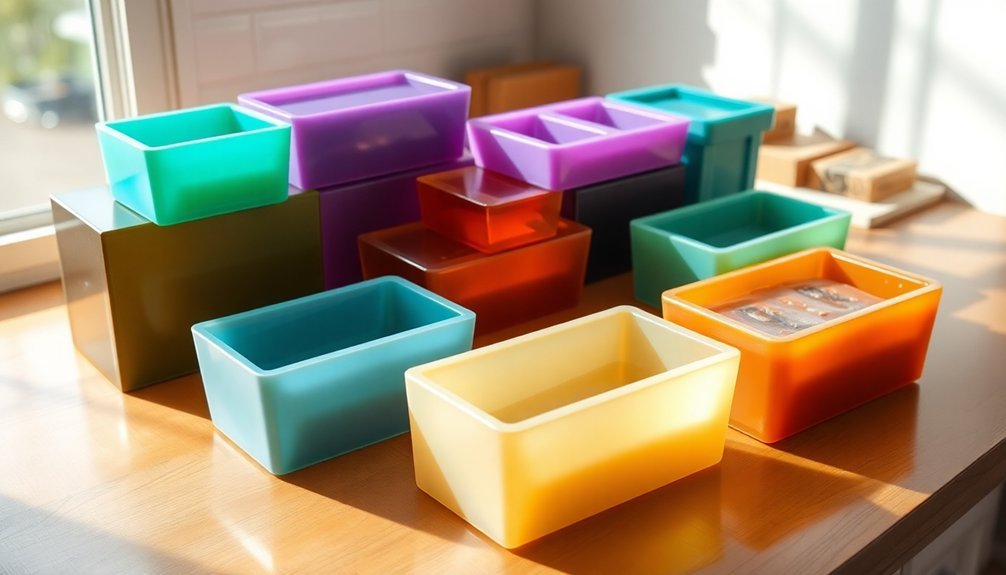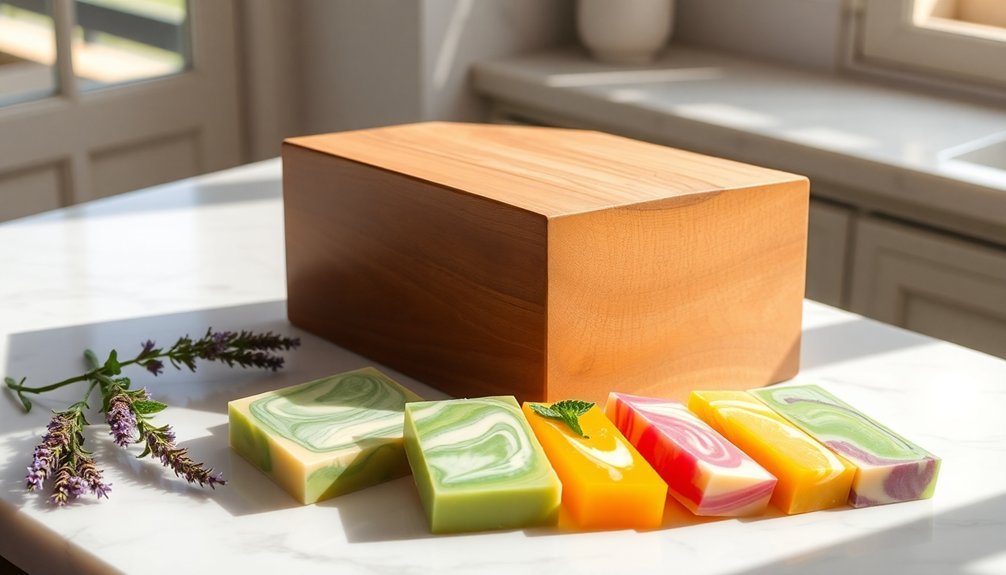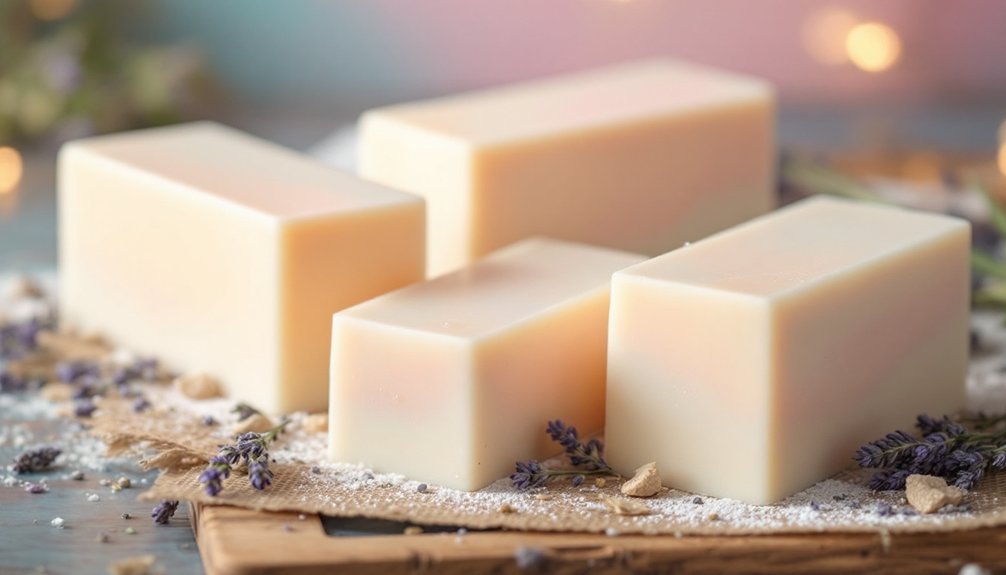Standard soap loaf molds for home makers typically range from 1-pound (16 oz) to 3-pound (55 oz) capacities. Beginners should start with smaller molds around 8-11.5" long, 2-5" wide, and 1.25-3.5" high, yielding 4-8 bars per batch. Medium 2-pound molds (10" x 3-4") produce 8-10 bars and offer a good balance for regular production. Your choice affects not only batch size but also curing requirements, storage needs, and customization options for your handcrafted bars.
Common Dimensions for Beginner Soap Loaf Molds

Five key dimensions define most beginner soap loaf molds, with sizes ranging from 8 to 11.5 inches long, 2 to 5 inches wide, and 1.25 to 3.5 inches high.
These measurements aren't arbitrary—they're designed to produce manageable batches for those just starting their soap-making journey.
When you're selecting your first loaf mold, consider that smaller options (around 8 × 2 × 1.25 inches) let you test recipes without wasting ingredients.
Most beginner-friendly molds yield four to eight one-inch soap slices per batch.
Capacity matters too—look for molds holding between 11 and 50 ounces.
Silicone molds are particularly popular for newcomers since they flex easily when you're ready to unmold your creation, eliminating the frustration of stuck soap that often discourages beginners.
Batch Size Calculations for 1-Pound Soap Loaf Molds
Most beginners find 1-pound soap loaf molds to be the perfect starting point for their soap-making journey.
With a standard capacity of 16 ounces and dimensions of approximately 10" × 3.5" × 2.5", these molds are easy to use and ideal for small-batch experimentation.
When planning your recipe, aim for about 450 grams (1 pound) of oils to fill a 1-pound soap loaf mold properly. This typically yields 4-6 standard bars, making it economical for testing new formulations without wasting ingredients.
Remember to account for the total weight of all components—oils, lye, and additives—when calculating your batch size.
Always calculate your total recipe weight including oils, lye, and additives to determine proper mold usage.
Many soap makers appreciate that these smaller molds minimize both material costs and the disappointment of potential batch failures while still producing enough bars to enjoy.
Medium-Capacity Molds: The 2-Pound Sweet Spot

Medium-capacity 2-pound soap molds offer you the perfect everyday size for consistent home production without overwhelming your space or supplies.
You'll appreciate the versatility and efficiency these molds provide, letting you create 4-6 full-size bars with each batch while experimenting with different recipes and additives.
If you're new to soapmaking, these beginner-friendly molds strike an ideal balance between manageable quantities and meaningful output, minimizing waste while you perfect your craft.
Perfect Everyday Size
The 2-pound soap loaf mold stands as the quintessential choice for home soap makers seeking balance between efficiency and practicality.
At approximately 10 inches long and 3-4 inches wide, these medium-capacity molds yield 8-10 standard bars per batch—perfect for personal use or small gifts.
You'll find the 2.5-3 inch depth accommodates various formulations, including recipes with herbs and essential oils.
Whether you're using cold process or melt-and-pour techniques, these molds provide consistent results and are easy to unmold once cured.
The beauty of 2-pound molds lies in their versatility—they're large enough to justify the effort of creating soap batches while small enough to minimize waste.
This size encourages experimentation without overcommitting resources, making it ideal for refining your craft through different recipes.
Versatility and Efficiency
While larger molds offer greater production capacity, the 2-pound soap loaf mold truly represents the sweet spot for most soap makers.
These medium-capacity molds typically yield 4-6 full-size bars per batch, making them perfect for testing new recipes without wasting resources.
With dimensions averaging 9-10 inches long, 3-4 inches wide, and about 3 inches deep, these molds accommodate various soap-making techniques from simple pours to complex swirls.
You'll appreciate their versatility when working with cold process soap or melt-and-pour methods.
The 32-44 ounce capacity strikes an ideal balance between efficiency and manageability.
You can experiment with new additives, colors, and designs without committing to large quantities, reducing potential financial loss while maximizing creative freedom.
Beginner-Friendly Option
For those just beginning their soap-making journey, 2-pound loaf molds offer an ideal entry point into the craft without overwhelming new artisans. Medium-capacity molds typically hold 40-44 oz of soap batter, yielding 4-6 full-sized bars that let you experiment without wasting materials.
| Feature | Benefit |
|---|---|
| 2-pound capacity | Perfect for small test batches |
| 40-44 oz volume | Manageable for beginners |
| Silicone material | Easy release and cleaning |
| 4-6 bars per batch | Efficient practice opportunities |
The popular Crafters Choice Tall & Skinny Loaf Silicone Soap Mold creates eight one-inch bars with its 3.5" × 2.5" × 8" dimensions. You'll appreciate how these beginner-friendly options allow you to refine techniques while minimizing financial risk compared to larger molds.
Scaling Up: 3-Pound Loaf Molds for Small Businesses

Small businesses shifting from hobbyist soap making to commercial production will find 3-pound loaf molds to be an ideal stepping stone.
These versatile molds typically measure about 10.25" x 3.5" x 3", providing the perfect dimensions to create professional, uniform bars once sliced.
With a capacity of 50-55 ounces, a 3-pound loaf mold strikes the balance between quantity and quality when making soap for retail. You'll minimize waste while producing enough inventory to meet growing demand.
Most 3-pound silicone molds can withstand temperatures up to 500°F, making them suitable for both cold process and melt-and-pour techniques.
This flexibility is essential when you're experimenting with large batches of soap for your expanding product line, offering cost-effective scaling without the financial risk of massive production runs.
Material Considerations When Selecting Mold Sizes
When choosing between silicone and wooden molds for your soap-making projects, you'll find each material offers distinct advantages for different loaf sizes.
Silicone molds provide flexibility and excellent heat resistance up to 500°F, making them ideal for both hot and cold process methods regardless of batch size.
Wooden molds, particularly those crafted from poplar or Baltic birch plywood, deliver superior insulation for cold process soaps but require careful consideration of potential warping when selecting larger dimensions.
Silicone vs. Wooden Molds
Choosing between silicone and wooden soap loaf molds requires understanding how each material affects your final product.
Silicone molds offer flexibility and durability, withstanding temperatures up to 500°F while making unmolding effortless. Options like the Tall & Skinny Loaf Silicone Soap Mold (44 oz) create distinctive bar shapes that stand out in your product line.
Wooden molds, often featuring silicone liners, provide superior structural support and insulation—ideal for cold process soap making where heat retention matters. You'll need to select appropriate wood types to prevent warping and chemical leaching.
While silicone molds come in standardized loaf sizes, wooden versions offer customization opportunities for varied batch volumes.
Consider your soap making technique when deciding: melt-and-pour methods work beautifully with silicone, while cold process soaps benefit from wooden molds' insulating properties.
Temperature Tolerance Differences
Although frequently overlooked by beginners, temperature tolerance represents an essential factor when selecting soap loaf mold sizes and materials.
Standard silicone molds typically withstand temperatures up to 500°F, making them versatile for both cold process and melt-and-pour soap recipes.
Before purchasing a mold, you'll need to verify its specific temperature rating. For instance, the Crafters Choice Elements mold handles up to 428°F, while Milky Way™ Big Loaf Molds can only tolerate 135°F. This variation considerably impacts which soap methods you can use safely.
Wooden molds present different challenges, as they're more susceptible to warping when exposed to excessive heat during saponification.
You'll need to take into account both your recipe's maximum temperature and your chosen mold's limitations to prevent damage and guarantee your soap cures properly.
Customizing Bar Dimensions From Standard Loaf Sizes

Three key approaches exist for customizing your soap bar dimensions using standard loaf molds. You can easily adjust the thickness, height, and overall size of your bars without purchasing new equipment.
Standard molds typically produce 1-inch thick bars, but you're not limited to these dimensions.
- Fill your mold halfway to create fewer but thicker bars—a standard eight-bar mold filled to 50% capacity yields four chunky bars.
- Modify bar height by adjusting how much soap you pour into the mold—depths ranging from 2.5 to 3.0625 inches give you flexibility.
- Select specialty molds like the Tall & Skinny Loaf Mold when you want consistently different proportions for your finished soap.
Your bar weights and sizes can be precisely controlled through these simple adjustments to your pouring and cutting techniques.
Storage and Curing Space Requirements by Mold Size
When planning your soap-making setup, adequate storage and curing space becomes just as important as selecting the right mold size. Your silicone mold dimensions directly impact the area you'll need to dedicate to your craft.
| Mold Size | Capacity | Required Space | Ventilation Needs |
|---|---|---|---|
| Small | 22 oz | Minimal | Standard |
| Standard | 44 oz | 12" x 12" | Moderate |
| Large | 104 oz | 24" x 12" | Significant |
| Multiple | Varies | 6-8" vertical per mold | Enhanced |
Smaller 22 oz molds are perfect if you're limited on space, while standard 44 oz options require a dedicated curing area. If you're using larger 104 oz molds, you'll need substantial room both for curing and storage. Remember that proper ventilation is essential for all sizes to prevent moisture retention during the curing process.
Frequently Asked Questions
How to Calculate Soap Mold Size?
To calculate soap mold size, you'll need to determine your desired soap bar dimensions first. Add one inch in height for expansion, and include the thickness of sideboards when measuring width and length for easy unmolding.
How Much Does a 10 Inch Soap Mold Hold?
A 10-inch soap mold typically holds up to 50 ounces of soap. You'll get about 6-8 standard bars when you slice it. The exact capacity depends on the mold's width and height dimensions.
Which Mold Is Best for Soap Making?
The best mold depends on your needs. If you're a beginner, try the Crafters Choice Regular Loaf Silicone Mold. For larger batches, you'll want the Long Loaf version with 104 oz capacity.
How Much Soap Goes in a Loaf Mold?
The amount of soap you'll need varies by mold size. Standard loaf molds hold between 11-104 oz, with popular options containing 44-55.6 oz. You'll want to fill your mold completely for best results.
In Summary
You've now explored the standard soap loaf mold sizes that will serve you well in your soap making journey. Whether you're starting with a modest 1-pound mold or scaling up to a 3-pound production model, choose dimensions that fit your batch calculations and workspace. Remember that your mold material affects not just durability but your finished bars' appearance. With the right sized mold, you'll create consistently beautiful soap every time.





Leave a Reply